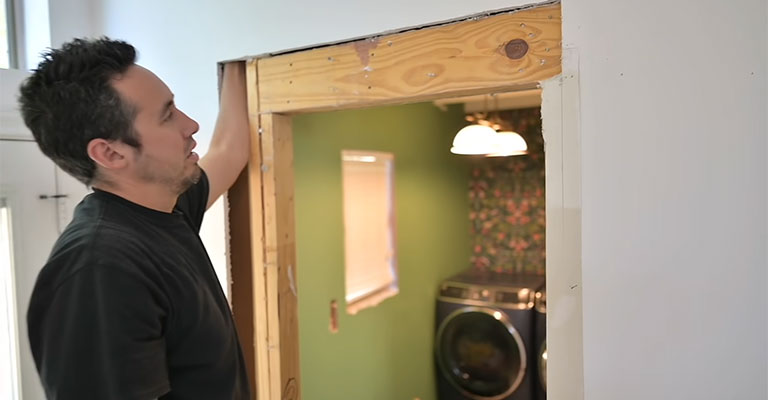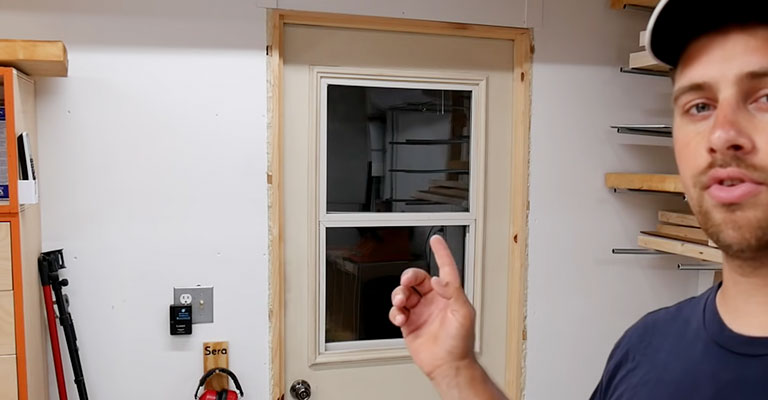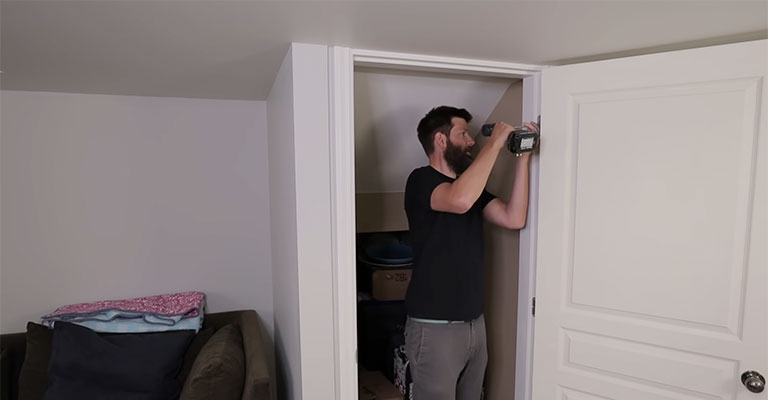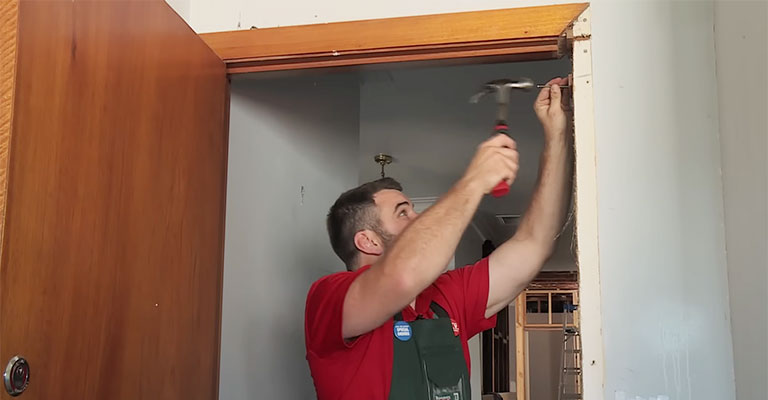You may have an “uh-oh” moment when you realize that the door is too short or narrow to fit in the opening you want to hang it in.
It is possible to build out the frame to accommodate a smaller door if you cannot find an appropriate door to cut down.
Furring out the jamb is usually all it takes to make the opening smaller if you want to keep the door the same.
Choosing the door that suits your needs and framing it out using whatever material will get you to the correct dimensions on top and on the sides.
It could be one by four, one by six, or even two by eight. It can be installed over the casing, and shimming can be trimmed as needed. However, extra wide trim may be required when it comes to trimming around the casing.
The door and frame can be matched in most cases if the difference is less than an inch. However, replacing the door casing with wider material may be necessary, or adding new drywall around the door frame if the difference is more significant.
What If You Could Make The Door Frame Smaller?

The process of making a door frame smaller isn’t difficult. Even though it’s an easy one to do, you shouldn’t need professional help for it.
To fit the smaller door, you will need to reduce the opening. Therefore, we need to replace the door lining. Doors that need to be replaced are more expensive.
When your door is more than an inch apart from the door frame, we recommend you seek assistance. Adding new drywall around your frame or replacing the door casing may be necessary if it is.
What Are The Steps For Making A Door Frame Smaller?

One side of the door can be pad-out if the size difference is less than one inch. The steps are as follows:
Step 1
A certain amount of measurement separates the door and frame. Calculate that difference. The frame only needs to be furred out on one side if the difference is less than 1 inch.
Furring out both sides may allow you to reuse the door casing if it’s more than that. You will need to lower the top jamb if the door is too short.
Step 2
With a pry bar, remove the door casing, the knob-side jamb, and the top jamb if only one side of the frame needs to be furled.
Removing the hinge-side jamb is recommended if you are narrowing the frame more than one inch. By prying off the entire jamb, you can make the frame shorter.
In addition, you should discard the shims that were behind the jamb pieces you removed.
Step 3
Slice 2-by-4-inch lumber into furring strips, cutting along the width, not the edge, with a table saw. Using a sharp blade and extending the saw blade to its full height will help you achieve this.
Step 4
Make sure that the strips are cut to the full length of the framing you will attach them. Remember to allow at least a 1/2-inch gap on each side of the door.
And one between the jamb and the top of the door when determining how thick to make them. The distance between the bottom of the door and the floor should also be 1/2- to 3/4-inch.
Step 5
Ensure the wood screws are long enough to bite into the framing at least an inch into the furring strips. Before driving screws into the strips, drill pilot holes with a 1/4-inch drill bit to prevent splitting.
Step 6
Fit the jamb pieces to the new opening using a circular saw. The top jamb should be cut if you have narrowed the opening.
And the end of the jamb should be rabbeted with a router and a 1/2-inch rabbeting bit. You might need to cut the bottoms off the side jambs if you have shortened the opening.
Step 7
Using new shims and a 4-foot level, plumb the jamb pieces you removed. Make sure the shims meet in the middle by tapping them together from opposite sides of the jamb.
To ensure the shims stay in place, drive two-inch finish nails into the jamb and the shims. Then, with a handsaw, remove the ends of the shims.
Step 8
A pair of 2-inch finish nails spaced approximately 10 to 12 inches apart should be used to nail off the jambs. Using a nail punch, sink the nails’ heads.
Step 9
Place the casing in place. The old casing could likely work if you narrowed the opening by a little less than an inch.
Fit the side casing over the gap between the jamb and the wallboard after cutting an amount off the top casing equal to the amount by which the frame has been narrowed. The bottoms of the side casing should be cut off if you shorten the opening.
Step 10
The old casing should be replaced with broader trim, or the wall modified. The trim may be available at your local lumberyard, but if not, you can use a table saw to make your own.
Modifying the wall requires attaching drywall to cover the furring strips, then taping and finishing it. The old casing can be reused after this modification.
Doors That Don’t Fit Frames

The casing and trim around a door can be reconfigured when re-hanging a door. There is no change to the door itself, but the surrounding area is slightly rebuilt to fit around it.
You won’t be able to solve all your problems with this hack, but it will solve any issues related to excessive gaps you may encounter.
Safety Tips When Making A Door Frame Smaller
Before undertaking this project, you will need to think carefully about a few things.

- A smaller door frame can be an attractive way to make a doorway appear more scaled-down and homey.
- Wear gloves and eye protection whenever you remove an old door frame since sharp edges may be present.
- When cutting the door frame, be sure to measure the opening. Doorframes should not be too small or too large for their openings.
- Cut away any existing framing with a handsaw or circular saw, as these saws are designed for cutting wood.
- You can prevent rust by using galvanized nails or screws when attaching the new door frame.
- Ensure that you caulk around the perimeter of the door frame to create a seal and to keep drafts at bay.
- Paint the door frame with high-quality exterior paint if you are painting it. Weather damage can be prevented by doing this.
Final Words
More than 6 inches of dimension change may necessitate reframing the opening instead of adding furring strips. As per the International Residential Code, the main exit door of a house must be 36 inches wide and 80 inches high.
Passage doors in interior and exterior areas cannot be narrower than the height requirement, but they must still comply with the width requirement. There is no restriction on the size of doors leading to storage areas.







